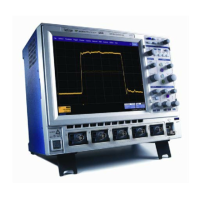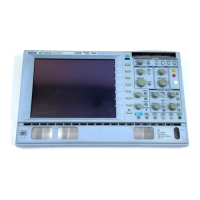WAVERUNNER XI SERIES
130 WRXi-OM-E Rev C
S
UMMED AVERAGING
Summed Averaging is the repeated ad on, with weight, of successive source waveform records. If a
stable trigger is available, the resulting a e ha se component lower than that of a single-shot
record. Whenever the maximum number of swee he averaging process stops.
An even larger number of records can umu hanging the number in the dialog. However, the
other parameters must be left unchang ne ion will be started. You can pause the
averaging by changing the trigger mod NO The instrument resumes averaging when
you change the trigger mode back to N M/AUT
You can reset the accumulated averag push CLEAR SWEEPS button or by changing an acquisition
parameter such as input gain, offset, co ng, tri ondition, timebase, or bandwidth limit. The number of
current averaged waveforms of the fun , or it , is shown in the acquisition status dialog. When summed
averaging is performed, the display is u ted at uced rate to increase the averaging speed (points and
events per second).
C
ONTINUOUS AVERAGING
Continuous Averaging, the default setti he r ted addition, with unequal weight, of successive source
waveforms. It is particularly useful for r cing no gnals that drift very slowly in time or amplitude. The
most recently acquired waveform has m eig all the previously acquired ones: the continuous average
is dominated by the statistical fluctuatio e cently acquired waveform. The weight of ‘old’ waveforms
in the continuous average gradually ten zero ng an exponential rule) at a rate that decreases as the
weight increases.
The formula for continuous averaging is
new average = (new data + weight * rag
This is also the formula used to compute summe ing. But by setting a sweeps value, you establish a fixed
weight that is assigned to the old avera e th sweeps is reached.
For example, for a sweeps (weight) val :
1
st
sweep (no old average yet): new a e = old average)/(0 + 1) = new data only
2
nd
sweep: new average = (new data + + 1) = 1/2 new data +1/2 old average
3
rd
sweep: new average = (new data + + 1) = 1/3 new data + 2/3 old average
4
th
sweep: new average = (new data + av ata + 3/4 old average
5
th
sweep: new average = (new data + old av + 1) = 1/5 new data + 4/5 old average
6
th
sweep: new average = (new data + ld av 1) = 1/5 new data + 4/5 old average
7
th
sweep: new average = (new data + old av ) = 1/5 new data + 4/5 old average
In this way, for sweeps > 4 the importa the egins to decrease exponentially.
diti equal
verag s a random noi
ps is reached, t
be acc lated simply by c
ed or a
e from
w averaging calculat
RM/AUTO to STOP.
OR O.
e by ing the
upli
ction
gger c
s zoom
pda a red
ng, is t epea
edu ise on si
ore w
ns of th
ht than
most re
ds to (followi
old ave e)/(weight + 1)
d averag
e number of ge onc
ue of 4
verag (new data +0 *
1*old average)/(1
2 * old average)/(2
3 * old erage)/(3 + 1) = 1/4 new d
4 * erage)/(4
4 * o erage)/(4 +
4 * erage)/(4 + 1
nce of old average b
Note: The number of sweeps used to compute the average will be displayed in the bottom line of the trace
descriptor label:

